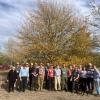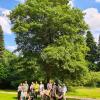Editor's Picks
Plant Focus
Project Contact: Valerie C. Pence, Ph.D., Director of Plant Research, Center for Conservation and Research of Endangered Wildlife (CREW), Cincinnati Zoo & Botanical Garden, Cincinnati, Ohio.
Project Summary: The 500 species of oaks (Quercus spp.) are iconic trees that anchor many of our most precious ecosystems. Of the 91 species of oaks in the US, 30% are of conservation concern due to loss of habitat, disease, and climate change. Conserving oaks in their habitats is crucial, but ex-situ, or off-site, conservation is also necessary to provide insurance against the loss of those species that are endangered in the wild.
Conserving oaks is challenging, because the seeds cannot survive the drying necessary to store them in seed banks. Species with such seeds are known as exceptional species. The Center for Conservation and Research of Endangered Wildlife (CREW) at the Cincinnati Zoo & Botanical Garden has taken a special interest in exceptional plants, including oaks, and specializes in the techniques needed for their conservation.
Oaks can be conserved as trees in botanical gardens, but there are also methods available for storing plant embryos and stem cells in liquid nitrogen. These methods, known as cryopreservation, take up little space and can preserve the tissues for decades, but the use of these methods for conserving oaks is just beginning. This project is directed at applying cryopreservation to endangered oaks and providing training information to assist others in developing similar research projects.
For this project, we will be focusing on stem cell, or shoot tip, cryopreservation. We have demonstrated its feasibility with the critically endangered Quercus hinckleyi. In this project, we will work with three threatened oak species, Q. arkansana, Q. havardii, and Q. acerifolia.
Further Reading
Shoot-Tip Cryopreservation for Oak Conservation
Gillian M. Ross and Valerie C. Pence (International Oaks No. 34)
Improving Shoot Survival In Vitro Through Ethylene Inhibition
Max Winkeljohn (International Oaks No. 34)
Shoot Tip Cryopreservation for Conserving Oak Biodiversity Ex Situ--with Updates
Valerie Pence and Gillian Ross
Presented during IOS Webinar #1 - August 29, 2023 (starting at 3:50 min)


















